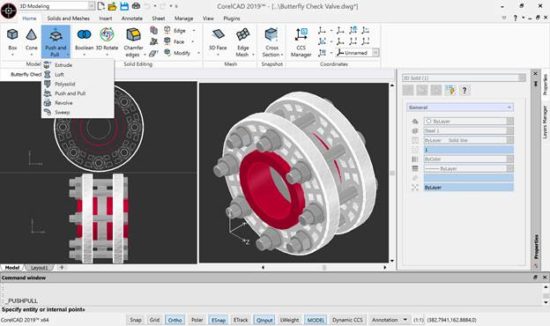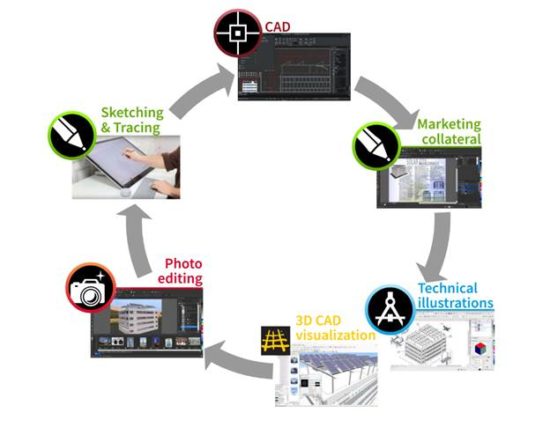Clone CADs are finding their space in a post-AutoCAD world.
As a CAD program based on the ODA DWG format and the Graebert Ares CAD engine, CorelCAD come late on to the scene. The Ares engine was introduced in 2005 and today Graebert is a leading provider of a CAD engine for development. The company got a major endorsement when Dassault chose Ares as the base for its Draftsight CAD program to accompany its products Catia and SolidWorks. Graebert has its own line of CAD programs, under the brand Ares Commander and OnShape has opted to use the Ares engine to drive its 2D drawing module. Each company has their own market to address and, in spite of the advantages and strength of 3D tools enabling advanced uses such as BIM and PLM, there is a very large market for 2D CAD products. The two worlds are not at all mutually exclusive.
Corel has a unique market selling CAD capabilities to its customers using its CorelDraw suite of products. Although CorelDraw is a direct competitor to illustration tools such as Adobe Illustrator, Corel’s customers tend to be technical users, thanks to Corel’s mix of tools devoted to technical illustration and also industrial graphics, sign making, apparel, creating schematics, and related markets. The Ares interface uses the comfy ribbon approach, designed to be familiar to AutoCAD users.
The Ares engine has support for Mac as well as Windows and CorelCAD is an enthusiastic supporter of the cross-platform capabilities, recognizing that many of its users tend to cross platforms and use mobile devices. CorelCAD has supported the Mac and last year CHK introduced the CorelCAD Mobile subscription which adds 2D drawing, editing, and annotation tools. CorelCAD Mobile is free to use as a viewer with annotation.

In many cases, CorelCAD users are not the original creators of CAD documents but they may need to edit DWGs to create technical documentation. Or they’re using CAD files to collaborate on projects or add additional information. Somewhere in the life of most projects, 2D drawings or files come into play.
This year’s version of CorelCAD 2019 introduces additional 3D modeling tools and 3D printing capabilities with additional STL support. The 3D modeling capabilities in CorelCAD have been enhanced with Push and Pull editing and other tools to enable more advanced 3D solids creation. Previously, 3D support has been pretty basic. Primarily, Corel is relying on the familiar paradigm of drawing a 2D shape and using it as a base for 3D. It’s limited for some advanced 3D shapes but it gets users who are more used to 2D a lot further the path to 3D.
CorelCAD 2019 also has support for STL enabling 3D access to 3D printing files including content available from sites like SketchFab and Shapeways.
Karl Vossen, senior product manager at Corel told us, “we’ve learned over the last few years that a significant portion of our customers is interested in creating in 3D.” He’s thinking that some of this interest comes from the maker community but also that 2D customers are adding on 3D skills.
A quick list of new features looks like this:
- New 3D modeling: Corel has added PolySolid to draw 3D objects in the shape of polygonal walls. Push and Pull tools enable users to add depth with extrusion. The new version also has ChamferEdges for beveling and new face and loop options. CorelCAD has had support for helix to create 3D models around a cylindrical shape and support for 3D primitives which can be added and edited with Boolean operations.
- Improved 2D drafting tools: CorelCAD has added support for CustomBlocks, a tool familiar to AutoCAD users. It lets users create and reuse blocks. Symbols can be defined with rules and constraints which lets users place them in drawings and resize, rotate as necessary.
- Layer Palette: CorelCAD has a new Layers Manager to replace an older implementation for layers. It’s more streamlined as a palette which can be put away, docked, and accessed directly within the UI. It also has a new MergeLayer feature.
- .STL file import: Import support for stereolithography (.STL) files to work with ready-made 3D designs or insert contained 3D solid objects into a new design. Plus, get support for 3D printing or output connection with .STL export.
- Improved selection tools: CorelCAD has added the ability to quickly click and cycle through entities in complex drawings and to find objects that might be hidden under other objects. They’ve also added Preview and Selection Highlighting. Colored highlighting lets users differentiate selected and hovered-over elements.
- Improved View options: New navigation features, which support 3D mice, also gives users the ability to view designs from different vantage points with RollView.
- Improved File format support: The ODA DWG has been updated to keep up with AutoCAD with full, native format support.

Pricing and availability
CorelCAD 2019 is available now in English, German, Spanish, French, Italian, Brazilian-Portuguese, Czech, Polish, Russian, Turkish, Simplified Chinese, Traditional Chinese, Japanese, and Korean. Pricing is USD 699/EUR 829.99/GBP 799 for the full version and USD 199/EUR 239.99/GBP 232.99 for the upgrade. UK and Euro prices include VAT. Education and volume licenses are available.
As mentioned, CorelCAD is also available via subscription from the Mac app store and from the Microsoft Windows story. Monthly subscriptions are priced at $34.99.
CorelCAD Mobile is available for iOS and Android for $99/€99.99/£89.99 annually or $9.99/€9.99/£8.99. Or as mentioned earlier free for a viewer version.
What do we think?
There are now more users using non-AutoCAD applications that produce DWG files than there are AutoCAD users. At first, the rationale for straying from the AutoCAD reservation was price and later, of course, there was the absolute affront of subscription, which forces customers to give up access to a program once their subscription expires.
In reality, price really isn’t that much of a challenge for most professional customers. The monthly price of an AutoCAD LT subscription is just $50 a month ($390/year). A full AutoCAD subscription is $195 a month ($1575/year). The full CorelCAD with 3D and LISP support fits right in there. The Ares Trinity program with Desktop, Mobile, and Cloud modules is $250 a year. A perpetual license of Draftsight is $300 or $149 per year subscription. Depending on their application, professional users using 2D drawing tools may likely be using companion CAD tools such as OnShape, SolidWorks, Inventor, Fusion, PTC Creo, etc. In other words, they’re likely spending quite a bit more money thn just the entry fee for a drafting tool.
It’s not about the money and it’s not really about AutoCAD, anymore.
New users may not feel the same obligation to use AutoCAD for 2D drafting and the standardization of the DWG format. The work of the ODA makes it easier for users to turn to other programs outside of Autodesk with the assurance that files are largely transportable. To be fair, Autodesk maintains a strong hold on its end of the market for people who are using other Autodesk programs. And there are legacy customers who are often using AutoCAD with a suite of plug-ins and their own in-house developed programs. They’re more likely to stand firm with Autodesk.
It’s a much bigger world with more options. We didn’t even touch on other programs like BricsCAD, which has been acquired by Hexagon, or alternatives like ZWCAD, which is primarily targeted to the China market and the Ascon C3D CAD kernel from Russia.





